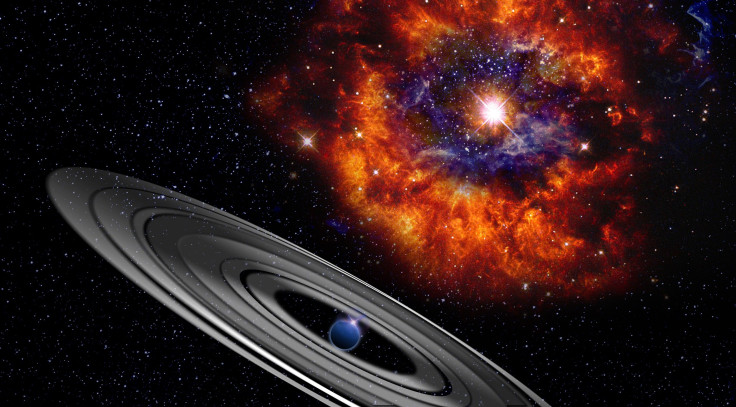Planet With Huge Rings Eclipses Star In Orion, Moons May Harbor Aliens

Scientists say a weird kind of eclipse is evidence of a giant planet with enormous rings that has yet to be discovered in the Orion constellation.
They’ve spotted the strange eclipse twice, and during both times the light from a star called PDS 110 that is 1,000 light years from Earth was reduced to a third of its usual brightness for almost a month, a study in the Monthly Notices of the Royal Astronomical Society found. Based on their observations, the researchers say it’s possible a gas giant, perhaps 50 times the mass of our own Jupiter, is passing in front of the star.
Read: Tiny Moons in Saturn’s Rings Make Weird Shapes
There was also a way the distant light fluctuated during the eclipse that suggests there are rings of dust around the planet. The University of Warwick, whose astronomers led the project, explained in a statement they came to this conclusion because the star’s light changed quickly during the eclipse. The rings they have predicted around the exoplanet are likely much larger than the ones that circle Saturn.
The star is young, only about 10 million years old, and is the same temperature as the sun. It’s slightly bigger though, and the exoplanet may orbit at a distance about double that between Earth and the sun.
Using telescope data “we found a hint that this was an interesting object,” lead author Hugh Osborn said in the university statement, “but it wasn’t until we found a second, almost identical eclipse … that we knew we had something special.”
Based on the time that passed between the two events, the researchers say the planet is taking more than 800 days to orbit the star before it starts to pass in front of it again. And the scientists plan to be watching when that happens in September, as can even amateur astronomers.
With careful observation, they might find a bonus: moons forming in the system.
“September’s eclipse will let us study the intricate structure around [the star] in detail for the first time, and hopefully prove that what we are seeing is a giant exoplanet and its moons in the process of formation,” Osborn said.
Those moons would be exciting for people who are searching for alien life, as they might be in their star’s habitable zone, the distance range from the star where its heat creates the right temperature to support living creatures as we understand them.
Read: Moon Volcanoes Make Jupiter’s Auroras Really Intense
Life on a moon is not as much of a longshot as it sounds. Widening their search from just planets themselves, scientists have been exploring the possibility of extraterrestrial life on moons in our own solar system. Enceladus, which revolves around Saturn, and Europa, which circles Jupiter, are particular points of intrigue, as their icy exteriors could be hiding vast subsurface oceans and heat sources. NASA has gone as far as designing a fleet of robots that could dig and melt through their icy surfaces to explore the worlds below.
If the scientists are right about the orbital period of this possible giant ringed planet orbiting PDS 1110 — almost two years and three months — this gas giant would be “the first giant ring system that has a known orbital period,” the University of Warwick said. “The eclipses can also be used to discover the conditions for forming planets and their moons at an early time in the life of a star, providing a unique insight into forming processes that happened in our solar system.”
© Copyright IBTimes 2024. All rights reserved.





















